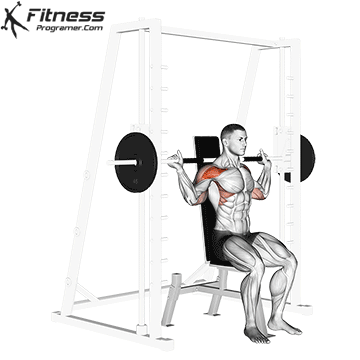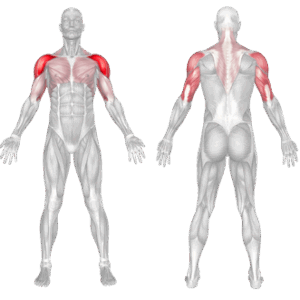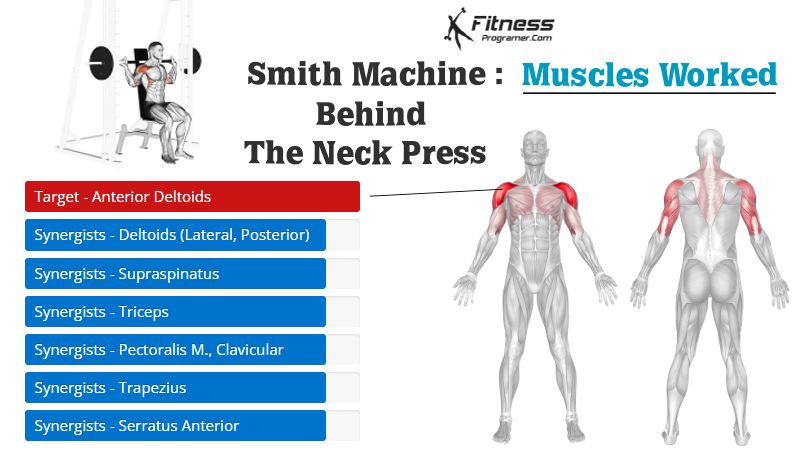Overview
The Smith Machine Behind the Neck Press is a compound strength training exercise that targets the shoulder muscles. It also secondarily engages the pectoral muscles and triceps.
Once a staple in bodybuilding and strength training routines, this exercise was popular for enhancing muscle definition and overall upper-body strength. However, modern fitness professionals often advise caution when performing it, as improper form can place excessive stress on the rotator cuff muscles, potentially leading to injury.
How to Perform:

- Starting Position: Sit on an upright bench or stand inside the Smith machine, positioning yourself so the bar rests behind your head, just above shoulder height.
- Grip and Posture: Grasp the bar with an overhand grip slightly wider than shoulder-width apart. Engage your core and maintain an upright torso.
- Pressing Movement: Push the bar upward by fully extending your arms, keeping your head slightly forward to avoid contact.
- Controlled Lowering: Slowly lower the bar back behind your neck until elbows form approximately a 90-degree angle, maintaining controlled tension in your shoulders.
- Repeat: Complete the desired repetitions, typically 8–12 reps per set.
Tips for Proper Form:
- Always perform this exercise slowly and under control.
- Avoid using excessively heavy weights to maintain shoulder safety.
- Keep your core tight and spine neutral to ensure stability.
- Ensure the bar travels straight vertically along the Smith machine rails.
Common Mistakes:
- Excessive Weight: Using too heavy a load can strain your shoulder joints and lead to injury.
- Incorrect Bar Path: Allowing the bar to drift forward or backward off the guided path increases risk of injury.
- Rapid Movement: Performing the exercise too quickly reduces muscle activation and increases injury potential.
Benefits of the Smith Machine Behind the Neck Press
- Targets All Deltoids: Precisely activates often-neglected shoulder muscles, enhancing overall shoulder definition and strength. Ideal for targeted shoulder hypertrophy, particularly if the goal is to stimulate the delts.
- Enhanced Shoulder Stability: Improves shoulder joint stability and reduces injury risk when performed with proper form and moderate weights.
- Supports Postural Improvement: Strengthening rear shoulder muscles contributes to better posture, reducing the likelihood of rounded shoulders.
- Controlled and Safe Movement Path: The Smith machine ensures safer execution by guiding the bar along a fixed vertical path.
- Versatile for Various Goals: Ideal for bodybuilding, strength training, and rehabilitation when performed under controlled conditions.
How to Incorporate Into Your Routine
- For Beginners: Begin with 2–3 sets of 10–12 reps using lighter weight to master form.
- For Hypertrophy: Perform 3–4 sets of 8–12 reps with moderate weight, emphasizing controlled repetitions.
- For Strength Building: Use 4 sets of 6–8 reps with heavier weights, allowing sufficient rest (2–3 minutes) between sets.
- For Functional Training: Combine with complementary exercises like front presses or lateral raises in a shoulder-focused workout.
Muscles Worked

Frequently Asked Questions
Is the Smith Machine Behind Neck Press safe for shoulders?
It can be safe when executed correctly, using moderate weights and proper form. Improper execution or heavy weights increase injury risk.
Can beginners perform the Smith Machine Behind Neck Press?
Beginners can perform it cautiously, prioritizing form over weight to avoid strain.
Does this exercise build muscle effectively?
Yes, it effectively develops shoulder muscle mass and definition when integrated into a consistent training routine.
Should I use this as my primary shoulder exercise?
Incorporate this exercise alongside others like dumbbell presses and lateral raises for comprehensive shoulder development.
How often should I include this exercise in my routine?
Typically, once or twice per week as part of a balanced shoulder-training regimen is sufficient.

